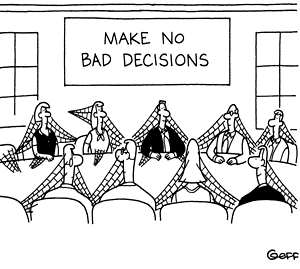MOST TECHNOLOGY PURCHASES ARE GROUP DECISIONS AND MANY SALES AND MARKETING ORGANIZATIONS ARE UNPREPARED TO SUPPORT THE BUYING PROCESS:
Buying and selling has become increasingly complex and purchases no longer hinge on “the decision maker”. On average, 5.4 people are involved in today’s B2B purchase decisions. This creates differences in opinion that make it increasingly hard to reach a decision and many organizations simply give up on purchases altogether. This scenario combined with a buyer- controlled purchasing process significantly increases the challenge for sales and marketing to influence the buying process.
Typically both business and IT functions are involved with initiatives tha
t require changes in their processes and technology and while the lines of responsibly are often blurred, IT is generally tasked with selecting the right product and evaluating all the vendors that might meet their business and technology requirements. This process usually involves a survey of the market landscape, discussions between internal stakeholders, in-depth analysis and comparison of solutions -often befor
e any direct engagement with vendors. However, with so many product/technology options, multiple opinions and competing demands it can be difficult to gain consensus on the best course of action and a vendor.
According to Harvard Business Review most suppliers’
efforts to support consensus fall short. Typically, marketing and sales try to boost individual purchase intent early on—and then sales tries to bring everyone together at the end. However, group conflicts actually peak early in the buying journey. The best sales and marketing teams focus on connecting buyers to each other—not just to the supplier—right from the start.
How Content Influences Buyers
When researching complex technology products enterprise buyers typically seek out guidance to inform their decisions from a huge universe of online content (product literature, white papers, blogs, etc.) and share this information across the multiple stakeholders in the buying process. This has made buyers less reliant on live conversations with vendors during the buying process- and has made it more difficult for vendors to directly impact their final purchase decisions.
As a result it has put much more pressure on vendors to deliver education at the beginning stages of the sales cycle and to provide a steady stream of informational content on how their product addresses a buyer's business and technical problems -and of course why your offering is best suited to solve those problems.

How Much Content Do I Need?
Creating effective awareness and education requires personalized relevant marketing – and a lot of content. Effective content requires gaining buyer knowledge and using tactics such as buyer personas, competitive positioning, and customer segmentation to deliver it to the right people at the right time.
Understanding the “Buyers Journey” for each persona should guide your content development. Persona development should in turn reflect the dynamic among the buying committee, especially what information each member needs to share with each other as it relates to different perspectives. Targeting only the elusive “decision maker” disregards the way business people actually buy – collaboratively.
Well-researched and articulated personas will provide the basis for strategies and tactics to address each stakeholders needs and promote consensus building that steers the group towards your offering. Personas that can’t be used to guide execution are of no use. As such personas should:
- Become a key input to help guide the development of relevant marketing programs
- Inform which topics need to be covered in your content to address the problems and goals that are important to the persona
- Take into account scenarios that could create opposition to making a purchase
- Be unique from all other personas to define a truly addressable role in the buying process
Personas can then be used to develop relevant and targeted content so that messages are delivered to the right person at the right stage in the buying cycle. And when you have the right content you will be able to
- Address specific market and buyer segments with your marketing programs to reach and engage, through a variety of tactics such as blogs, social media, webinars, whitepaper, etc..
- Build a storyline across the buying committee and the continuum of the buying process that ties together and enables mapping content to needs and priorities at different points of decision making
Your success depends on reaching the entire decision making team and relies heavily on Sales and Marketing being aligned and working together to maintain consistent focus on these points.
CONCLUSION:
You must account for the whole buying committee- the cost of not taking this approach, and continuing to focus on “the C-level decision maker” is quite high. At the same time, what is one of the biggest problems in B2B sales and marketing is also one of the biggest opportunities if it is addressed properly. If you can provide each stakeholder in the buying panel with tailored messaging that shows the product to them in a way that is most relevant to them and their role in the organization, it will help build a consensus and keep the conversation focused on your offering.
It’s cliché but knowledge is power, so don’t limit the information you provide –your champions who want to purchase your product need your support to push it through.
